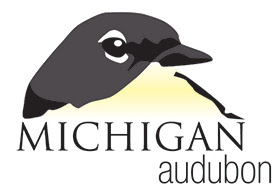 |
| Photo Credit - Michigan Audubon
Compact Grey Feeder Birds
Identification tips
Each winter more and more people feed birds in their backyard. As this hobby grows across the U.S. the urge to know specific species gets greater. Below are three birds you will likely see at your feeder that all share a common color – grey!
Dark-eyed Junco
Referred to as the snowbirds of the middle latitudes, Dark-eyed Juncos are common birds in  Michigan this time of year. The bird is a ground feeder, found in large flocks that that typically include a hierarchy or pecking order; early arrivals tend to have higher ranks. Additionally, these birds are very talkative; they chip almost absent mindedly. Michigan this time of year. The bird is a ground feeder, found in large flocks that that typically include a hierarchy or pecking order; early arrivals tend to have higher ranks. Additionally, these birds are very talkative; they chip almost absent mindedly.Size: 5.5-6.3 inches long Wingspan: 7.7-9.8 inches Weight: 0.6-1.1 ounces Coloration: Juncos vary in color widely across their range, having recorded 15 different regional races, six of which are easily recognizable in the field. Of those six, two are widespread throughout the US; the “slate-colored” and the “Oregon” junco. In general, Dark-eyed Juncos are described as being dark grey or brown birds with a rounded head and short, stout pink bill with white outer tail feathers.
Tufted Titmouse
A small songbird with a rebellious Mohawk and an echoing call, the Tufted Titmouse is another grey and vocal backyard bird. In the winter they are found in the company of nuthatches, .jpg) chickadees, kinglets and woodpeckers. They are quick to respond to the sounds of agitation in other birds, their curiosity leads them to investigate often and they commonly join in with other birds when mobbing a predator. chickadees, kinglets and woodpeckers. They are quick to respond to the sounds of agitation in other birds, their curiosity leads them to investigate often and they commonly join in with other birds when mobbing a predator.Size: 4.5-5.5 inches long Wingspan: 7-9 inches Weight: 0.6-0.9 ounces Coloration: The Tufted Titmouse is a silvery/gray color on its back and wings with a white belly. It has a rusty or peach-colored wash down the flanks and a black patch just above the bill which makes the bird look snub-nosed.
White-breasted Nuthatch
The largest species of nuthatch this bird is observed climbing up, down and side-to-side over tree trunks and around large branches looking for food sources. They search crevices in the bark to find food. White-breasted Nuthatches are very territorial all year long. In the winter, they join %202.jpg) flocks of chickadees and titmice in order to find abundant food and have more birds to keep an eye out for predators. According to Cornell Lab, “One study found that when titmice were removed from a flock, nuthatches were more wary and less willing to visit exposed bird feeders.” flocks of chickadees and titmice in order to find abundant food and have more birds to keep an eye out for predators. According to Cornell Lab, “One study found that when titmice were removed from a flock, nuthatches were more wary and less willing to visit exposed bird feeders.”Size: 5.1-5.5 inches long Wingspan: 7.9-10.6 inches Weight: 0.6 to 1.1 ounces Coloration: The coloring of these nuthatches is very crisp. They display a grey-blue back, with a black or grey cap/neck which frames the frosty white face and underparts, making the bird look like it is wearing a hood. A little bit of chestnut coloring is found on the lower belly and under the tail. Active and talkative all three grey birds possess their own distinctive feature. After doing your backyard birding make sure to upload your checklist to www.ebird.org to help ornithologist determine population numbers and locations of these common birds. If you enjoy information like this be sure to renew or join Michigan Audubon as a member and learn about all of Michigan's birds in our bi-monthly magazine, the Jack Pine Warbler. Good luck and happy backyard birding! Your Bird Crew, |
Friday, February 7, 2014
Subscribe to:
Post Comments (Atom)


No comments:
Post a Comment